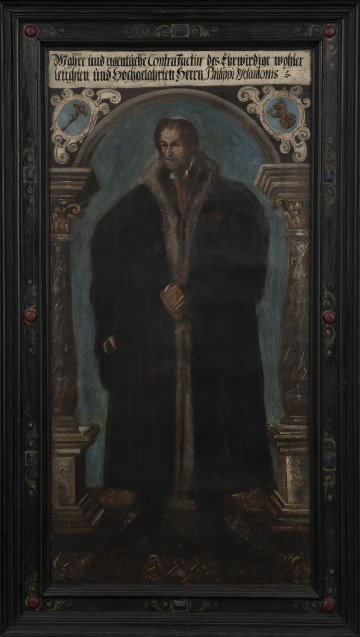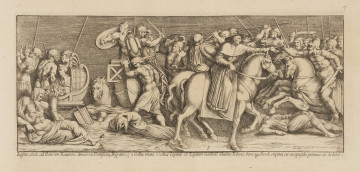
Portrait of Philip Melanchthon
circa 1560 — 1580
National Museum in Szczecin
Part of the collection: Graphics of German speaking countries
Erwin Lang's composition is a portrait of a Chinese scholar sitting at a table. An older man with a face covered with furrows accentuating eastern features is concentrated on a sheet of paper lying in front of him. He is carefully holding the card with one hand while using the other hand's index finger to mark some vital spot. The scholar is dressed in a thick dark kaftan or coat and a round, flat cap. His long beard flows over his chest, and an uncut moustache hangs under his nose. The graphic was made in 1922 using the woodcut technique (from a block cut along the grain) and printed on handmade ribbed paper. It was published by the Gesellschaft für Vervielfältigende Kunst (Society for Graphic Arts) in Vienna, in the annual portfolio of artistic publications (Jahresmappe) for 1922.Erwin Lang was born in 1886 in Vienna and died there in 1962. He was educated at the Kunstgewerbeschule (School of Arts and Crafts) in Vienna. He was a disciple of the representatives of the Vienna Secession - Alfred Roller, Carl Otto Czeschka and Erich Mallina. Lang worked as a painter, graphic artist and stage designer. He gained recognition early in his artistic career with posters and stage designs made in Vienna and Berlin. In 1908, the first exhibition of his drawings and woodcuts took place in the Exhibition Hall in Vienna. In 1911, together with the representatives of Expressionism Oskar Kokoschka and Egon Schiele, he took part in an exhibition of paintings in the halls of the Hagebund Association in Vienna. In 1914, he was awarded the State silver medal for his work. During the First World War, he was a front-line soldier and a prisoner of war in a Russian camp. His escape from the camp via China probably provided him with artistic inspiration and resulted in the performance of the work discussed here. From 1920, Lang continued his creative work as a stage designer. He belonged to artistic associations - the Vienna Secession and the Hagebund (in 1925-1938), which enabled him to have close, creative contacts with representatives of classical Modernism trends.
Ewa Gwiazdowska
Author / creator
Dimensions
cały obiekt: height: 446 mm, width: 555 mm
Object type
graphic
Creation time / dating
Creation / finding place
Identification number
Location / status

circa 1560 — 1580
National Museum in Szczecin

1923
National Museum in Szczecin

1680
National Museum in Szczecin
DISCOVER this TOPIC
Museum of King Jan III's Palace at Wilanów
DISCOVER this PATH
Educational path